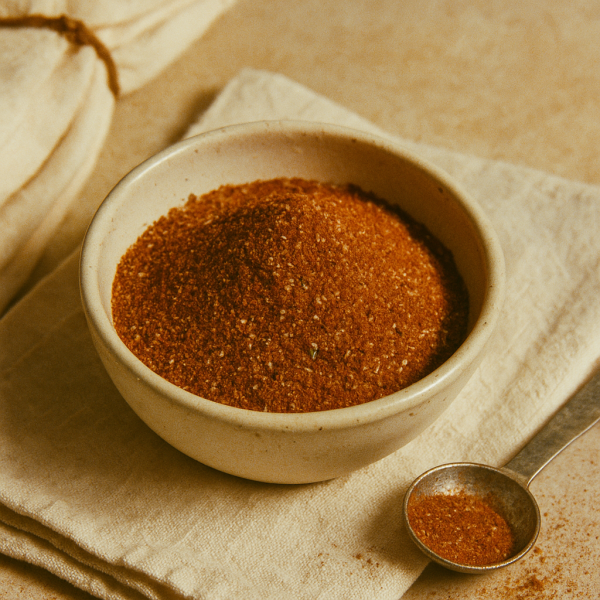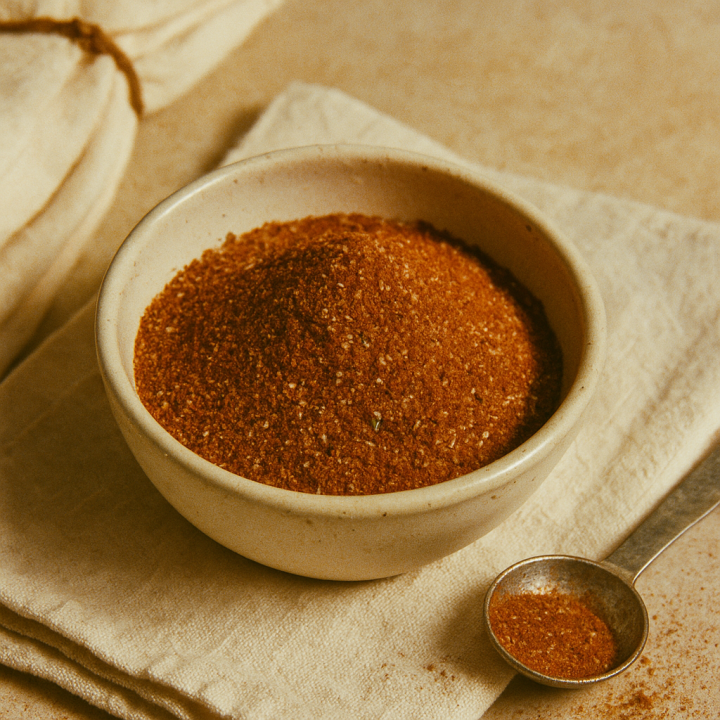Use This Smoky, Spicy, Homemade Cajun Seasoning Recipe To Flavor Everything!

This homemade Cajun seasoning recipe is smoky, spicy, and way better than anything you’ll find in a store-bought shaker.
If you’ve ever reached for a Cajun blend and been hit with more salt than spice (or worse), or tasted something that could pass for taco seasoning in disguise, it’s time to upgrade. My version strikes that perfect Southern balance of heat, depth, and flavor, without any sneaky additives or mystery fillers.
You’ll learn:
- The ideal paprika blend for real Cajun flavor
- The must-have spices (and what to skip)
- How to store it for max freshness and flavor
So grab your spice jars and a clean mixing bowl. We’re about to make something bold, fiery, and fabulous.
Why This Cajun Seasoning Recipe Works
What makes this Cajun seasoning so good? It’s bold without being overpowering, smoky without tasting like a campfire, and spicy enough to wake up your taste buds but not so hot it hijacks your dinner. You get flavor first, heat second, and balance all the way through.
A lot of store-bought Cajun blends rely heavily on salt or cheap fillers, which dull the complexity. This homemade version lets each spice shine, especially the smoked paprika and garlic powder, which do the heavy lifting in creating that rich, earthy flavor Cajun food is famous for.
It works because:
- ✅ You can make it in 5 minutes with pantry staples
- ✅ You control the salt and spice level
- ✅ It tastes amazing on everything from shrimp to roasted potatoes
- ✅ It’s preservative-free and customizable
Once you make a batch, don’t be surprised if it becomes your go-to flavor booster for busy weeknights.
Ingredients + Shopping Tips
You probably have everything you need in your spice cabinet already, but getting the right versions of a few key ingredients will take this blend from good to downright irresistible.
Here’s what you’ll need:
- Smoked paprika (2 tbsp) – This adds a rich, smoky depth that regular paprika just can’t touch. It’s the backbone of the whole blend.
- Garlic powder (1 tbsp) – Go for garlic powder, not garlic salt. It has more flavor and no sodium overload.
- Onion powder (1 tbsp) – Builds that savory, umami base Cajun food is known for.
- Dried oregano (1 tsp) – A classic herb in Cajun cooking. Don’t skip it.
- Dried thyme (1 tsp) – Adds a woodsy, aromatic note that rounds everything out.
- Cayenne pepper (½ to 1 tsp) – This is where the heat lives. Start low and adjust to your spice tolerance.
- Black pepper (1 tsp) – A touch of bite that layers well with cayenne.
- White pepper (½ tsp) – Optional, but it gives a deeper warmth that black pepper doesn’t.
- Salt (1 tsp) – Totally optional: leave it out if you want a salt-free blend or plan to salt dishes separately.
Substitution Notes:
- No smoked paprika? Use regular and add a tiny pinch of chipotle powder for smoke.
- Out of thyme? Italian seasoning will do in a pinch.
- Want a salt-free version? Just leave it out. This blend still brings the flavor.
Step-by-Step Instructions
Mixing up your own Cajun seasoning takes less time than digging through your spice drawer looking for that half-empty store-bought bottle.
1. Measure your spices.
Level off your tablespoons and teaspoons for accuracy, especially with the paprika and cayenne. A little too much cayenne and your “flavorful dinner” becomes a five-alarm fire.
2. Combine everything in a small bowl.
Use a spoon or mini whisk to blend thoroughly. You want an even mix so no single spice takes over.
3. Taste and tweak.
Dip a finger in and taste a tiny pinch. Want it spicier? Add more cayenne. Milder? Cut back a smidge next time. You’re the boss here.
4. Transfer to an airtight container.
Glass spice jars or old mason jars work perfectly. Label it with the date and name so you don’t accidentally grab it thinking it’s taco seasoning.

Smoky, Spicy, Homemade Cajun Seasoning Recipe
This homemade Cajun seasoning recipe is smoky, spicy, and packed with flavor. Easy to customize and perfect for shrimp, chicken, pasta, and more, it’s a pantry staple you’ll reach for again and again.
Ingredients
- 2 tablespoons smoked paprika
- 1 tablespoon garlic powder
- 1 tablespoon onion powder
- 1 teaspoon dried oregano
- 1 teaspoon dried thyme
- ½ to 1 teaspoon cayenne pepper (adjust to taste)
- 1 teaspoon black pepper
- ½ teaspoon white pepper (optional)
- 1 teaspoon salt (optional)
Instructions
- Add all spices to a small bowl or jar.
- Stir or shake until evenly combined.
- Taste a pinch and adjust cayenne for more or less heat.
- Store in an airtight container in a cool, dark place for up to 6 months.
Notes
Keep your Cajun seasoning in a glass jar or sealed spice container in a cool, dark pantry. Add a few grains of uncooked rice to prevent clumping. Flavor is best within the first 6 months.
Storage & Shelf Life
Once you’ve mixed up your Cajun seasoning, you’ll want to keep it fresh and flavorful for as long as possible, because trust me, you’ll be reaching for it often.
Best Way to Store It:
- Use an airtight container like glass spice jars with screw tops or even a repurposed baby food jar work great.
- Keep it in a cool, dark place, like your pantry or spice cabinet. Light and heat can zap the flavor faster than you’d think.
Shelf Life:
- For best flavor, use within 6 months.
- After that, it’s still safe to use, but the boldness of the spices will start to fade.
- Tip: If it clumps, toss a few dry, uncooked rice grains in the jar to absorb moisture.
How to Use Cajun Seasoning
Once you’ve got a jar of this bold, smoky blend, you’ll want to start sprinkling it on just about everything… and honestly, you should.
Here are some of the best ways to put your Cajun seasoning to work:
Classic Cajun Favorites:
- Cajun Shrimp – Toss peeled shrimp in a little oil and seasoning, then sear or grill. Serve over grits, salad, or tucked into tacos.
- Cajun Chicken – Rub chicken thighs or breasts before baking, grilling, or air-frying. Juicy and flavorful every time.
- Cajun Pasta – Stir into cream sauce for a spicy, smoky Alfredo. Add shrimp or sausage and you’ve got dinner done.
- Cajun Rice – Mix into white or brown rice with sautéed bell peppers, onion, and a protein for an easy one-pot meal.
- Cajun Fries – Sprinkle over fresh-from-the-oven fries (or frozen ones) with a drizzle of oil before baking. Serve with ranch or spicy ketchup.
- Cajun Sausage – Use it to season homemade sausage patties or slice smoked sausage into pasta, jambalaya, or breakfast scrambles.
- Cajun Wings – Toss wings in the seasoning before air frying or baking. Finish with a buttery hot sauce glaze for serious heat.
- Cajun Sauce – Stir into mayo, sour cream, or ranch for a quick dipping sauce with kick. Great for sandwiches, burgers, or fries.
Substitutions & Variations
The beauty of homemade seasoning is that you can tweak it to fit your taste or whatever’s in your pantry. Whether you like it extra spicy or need to skip the salt, this Cajun blend is easy to customize.
Heat Control:
- Milder version – Cut the cayenne in half (or leave it out entirely) and add a little extra smoked paprika to keep that bold flavor without the burn.
- Spicier version – Double the cayenne or add crushed red pepper flakes for extra heat.
Salt-Free:
- Want more control over the salt in your cooking? Just leave it out of the blend and add it separately to each dish as needed. Perfect for low-sodium diets.
Smoky vs. Sweet:
- No smoked paprika? Use sweet paprika instead and add a pinch of chipotle powder if you still want that smoky edge.
- Prefer a BBQ-style rub? Add 1 tablespoon of brown sugar. This is especially great for grilled chicken or pork.
Herb Switch:
- No oregano? Basil or marjoram work in a pinch.
- Add a little celery seed for a Creole-style twist.
Cajun Seasoning FAQs
Here are some straightforward answers to the most common questions I get asked about Cajun seasoning recipe.
1. What spices are in Cajun seasoning?
Cajun seasoning typically includes a bold blend of spices like paprika, garlic powder, onion powder, black pepper, cayenne pepper, oregano, and thyme. Some versions may also add white pepper, salt, crushed red pepper flakes, or celery seed. The exact ratios can vary by cook, but the core flavor comes from smoky paprika and garlic, balanced by herbs and heat.
The great thing about making your own is that you can adjust the intensity. Use more cayenne for extra heat or add a bit of brown sugar for a slightly sweet contrast. It’s a super versatile spice mix and easy to customize.
2. Is Cajun seasoning the same as Creole seasoning?
No, while they’re often used interchangeably, Cajun and Creole seasonings are distinct. Cajun seasoning tends to be spicier, simpler, and more rustic, usually focusing on a hot-and-savory blend of spices and herbs. Creole seasoning is more herb-forward and often includes basil, bay leaf, and sometimes parsley for a more aromatic profile.
Think of it this way: Cajun seasoning is bold and fiery, perfect for blackened meats. Creole seasoning leans a bit more refined and complex, ideal for stews and sauces like étouffée or gumbo.
3. How spicy is Cajun seasoning?
Cajun seasoning can be moderately to very spicy, depending on how much cayenne and crushed red pepper are used. Most homemade blends aim for a gentle kick that enhances flavor without overwhelming it, enough to wake up your taste buds, but not so much that it scorches them.
If you’re spice-sensitive or cooking for kids, you can easily dial back the cayenne and red pepper flakes in your homemade mix. On the flip side, if you like it hot, bump them up a notch. That’s the beauty of DIY seasoning blends — full control over the heat!
4. Can I make Cajun seasoning without salt?
Yes, you can absolutely make salt-free Cajun seasoning, and it’s a smart move if you’re watching your sodium intake or just want better control over how much salt goes into your food. Simply leave out the salt from any recipe you’re following, and add salt to your dishes separately during cooking or at the table.
This is especially helpful when seasoning proteins or veggies that already have other salty ingredients like broth, cheese, or brined meats. A salt-free blend also makes a great base to customize for specific recipes.
5. What can I use Cajun seasoning on?
Cajun seasoning is incredibly versatile and works well on just about everything. It’s perfect for blackened chicken or fish, shrimp, roasted vegetables, or even grilled corn. Stir it into soups, sprinkle it over popcorn, mix it with breadcrumbs for coating meats, or toss it with roasted potatoes for a spicy kick.
It’s also great in creamy sauces: think Cajun pasta, Cajun mac and cheese, or even added to homemade ranch dressing for a bold twist. Once you start experimenting, it becomes a go-to spice mix for weeknight cooking.
Try These Recipes Next
Now that you’ve got your own Cajun seasoning on hand, you’re just a few steps away from turning everyday meals into something downright crave-worthy. Here are a few recipes that let this blend shine:
- 👉 Cajun Shrimp & Quinoa Casserole
- 👉 Creamy Chicken and Pasta Skillet
- 👉 20 Minute Easy Tortellini Bake
